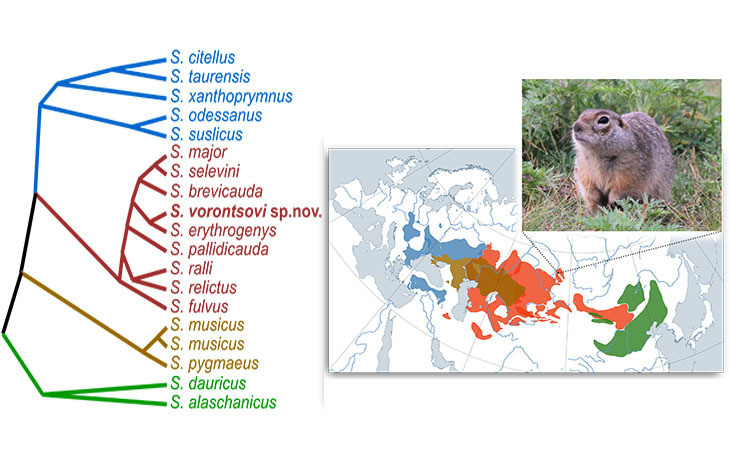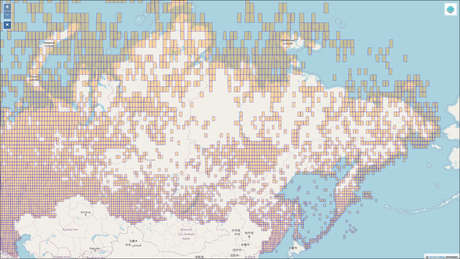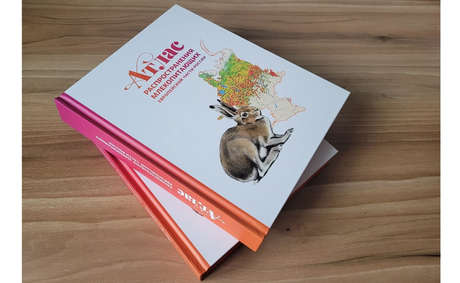2024-03-16

The study of the relationships of the sousliks of the Palearctic has led to an increase in the number of species of the genus and the description of a new species
Palearctic ground squirrels (genus Spermophilus) are a characteristic faunal element of the Eurasian steppes and play an important role in maintaining these landscapes. A recent study published by a team of Russian authors in the journal Molecular Phylogenetics and Evolution, based on a multilocus analysis using five mitochondrial and five nuclear markers, studied the phylogeny of all taxa of the genus. The results obtained are important for the taxonomy of Spermophilus. The changes relate to widespread species whose populations are separated by geographical barriers - large rivers flowing in a meridional direction.
"Speckled" ground squirrels. It is proposed to recognize the speckled ground squirrel, S. suslicus, living east of the Dnieper to the Volga, and the Podolsk ground squirrel, S. odessanus, inhabiting the territory west of the Dnieper as separate species.
"Lesser" ground squirrels. The independent species status of two small ground squirrels separated by the Volga River has been confirmed. The species name S. pygmaeus remains with the eastern small ground squirrels, distributed from the Volga to Betpak-Dala. The Western small ground squirrels living west of the Volga to the lower reaches of the Dnieper, as well as in the Crimea and the Pre-Caucasus, have been given the name S. musicus, since it is the senior synonym belonging to the western line. It should be noted that S. musicus is not only a mountain ground squirrel, but all lesser ground squirrels on the right bank of the Volga.
"Red-cheeked" ground squirrels. A complex group of taxa that often united unrelated (paraphyletic) species of ground squirrels living in Western Siberia, eastern Kazakhstan and northwestern China. It is proposed to consider as separate species: the short-tailed ground squirrel, or Brandt's ground squirrel, S. brevicauda (eastern Kazakhstan, northwestern China) and Selevin's ground squirrel, S. selevini (Kazakh small-leaved ground squirrel, from the Turgai basin in the west to the Irtysh in the east). In addition, the red-cheeked ground squirrel itself consists of two lines living on different shores of the Ob River. S. erythrogenys lives on the western shore and up to the Irtysh (Kulundinskaya plain and foothills of Altai), and on the eastern shore of the Ob (in a small area around the Salair ridge and up to the western slopes of the Kuznetsk Alatau) a new species is Vorontsov's ground squirrel, S. vorontsovi. In addition to the multilocus analysis, genomic and morphological data were used to describe the new species.
As a result, the list of species of ground squirrels living in our country has been replenished with three species: a newly described species (S. vorontsovi) and two whose status has changed as a result of the division of taxa (S. musicus and S. selevini).
Source: Simonov E., Lopatina N.V., Titov S.V., Ivanova A.D., Brandler O.V., Surin V.L., Matrosova V.A., Dvilis A.E., Oreshkova N.V., Kapustina S.Yu., Golenishchev F.N., Ermakov O.A., 2024. Traditional multilocus phylogeny fails to fully resolve Palearctic ground squirrels (Spermophilus) relationships but reveals a new species endemic to West Siberia // Molecular Phylogenetics and Evolution. Vol. 195. 108057. https://doi.org/10.1016/j.ympev.2024.108057
The research was supported by the RSF project 22-24-00913 https://rscf.ru/project/22-24-00913/


